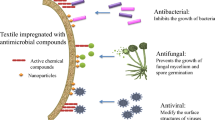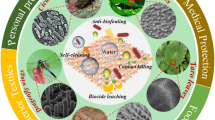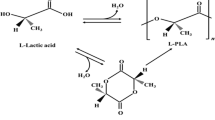Abstract
Three heterocyclic N-halamine structures containing amine, amide, or both functional groups were immobilized onto cotton fabric through epoxide tethering. The coatings were rendered biocidal upon exposure to dilute household bleach solution. The coatings exhibited superior biocidal functionality with complete inactivation of about 6 logs of Staphylococcus aureus and Escherichia coli O157:H7 within 2–10 min contact time depending on the structure. Moreover, the coatings were quite stable against repeated laundering so that recharging was not even necessary after 50 washing cycles. Stability of the coatings against ultraviolet light exposure was studied with a comparison of the amide- and amine-containing N-halamines.





Similar content being viewed by others
References
Akdag A, Okur S, McKee ML, Worley SD (2006) The stabilities of N–Cl bonds in biocidal materials. J Chem Theory Comput 2(3):879–884
Cerkez I, Kocer HB, Worley SD, Broughton RM, Huang TS (2011) N-halamine biocidal coatings via a layer-by-layer assembly technique. Langmuir 27(7):4091–4097
Chen Z, Sun Y (2006) N-halamine-based antimicrobial additives for polymers: preparation, characterization, and antimicrobial activity. Ind Eng Chem Res 45(8):2634–2640
Colak S, Tew GN (2008) Synthesis and solution properties of norbornene based polybetaines. Macromolecules 41(22):8436–8440
Denyer SP, Stewart G (1998) Mechanisms of action of disinfectants. Int Biodeterior Biodegradation 41(3–4):261–268
El-Shishtawy RM, Asiri AM, Abdelwahed NAM, Al-Otaibi MM (2011) In situ production of silver nanoparticle on cotton fabric and its antimicrobial evaluation. Cellulose 18(1):1–8
Gagliotti C, Balode A, Baquero F, Degener J, Grundmann H, Gür D, Jarlier V, Kahlmeter G, Monen J, Monnet DL (2011) Escherichia coli and Staphylococcus aureus: bad news and good news from the European Antimicrobial Resistance Surveillance Network (EARS-Net, formely EARSS), 2002 to 2009. Euro Surveill 16:1–5
Goddard JM, Hotchkiss JH (2008) Rechargeable antimicrobial surface modification of polyethylene. J Food Protection&# 174; 71(10):2042–2047
Kenawy ER, Worley SD, Broughton R (2007) The chemistry and applications of antimicrobial polymers: a state-of-the-art review. Biomacromolecules 8(5):1359–1384
Klibanov AM (2007) Permanently microbicidal materials coatings. J Mater Chem 17(24):2479–2482
Kocer HB, Akdag A, Ren X, Broughton RM, Worley SD, Huang TS (2008) Effect of alkyl derivatization on several properties of N-halamine antimicrobial siloxane coatings. Ind Eng Chem Res 47(20):7558–7563
Kocer HB, Cerkez I, Worley SD, Broughton RM, Huang TS (2011a) Polymeric antimicrobial N-halamine epoxides. ACS Appl Mater Interfaces 3(8):3189–3194
Kocer HB, Worley SD, Broughton RM, Huang TS (2011b) A novel N-halamine acrylamide monomer and its copolymers for antimicrobial coatings. React Funct Polym 71(5):561–568
Liang J, Chen Y, Ren X, Barnes K, Worley SD, Broughton RM, Cho U, Kocer H, Huang TS (2007) Fabric treated with antimicrobial N-halamine epoxides. Ind Eng Chem Res 46(20):6425–6429
Lin J, Winkelmann C, Worley SD, Broughton RM, Williams JF (2001) Antimicrobial treatment of nylon. J Appl Polym Sci 81(4):943–947
Qian L, Sun G (2004) Durable and regenerable antimicrobial textiles: improving efficacy and durability of biocidal functions. J Appl Polym Sci 91(4):2588–2593
Ren X, Kocer HB, Kou L, Worley SD, Broughton RM, Tzou YM, Huang TS (2008a) Antimicrobial polyester. J Appl Polym Sci 109(5):2756–2761
Ren X, Kou L, Liang J, Worley SD, Tzou YM, Huang TS (2008b) Antimicrobial efficacy and light stability of N-halamine siloxanes bound to cotton. Cellulose 15(4):593–598
Ren X, Akdag A, Zhu C, Kou L, Worley SD, Huang TS (2009) Electrospun polyacrylonitrile nanofibrous biomaterials. J Biomed Mater Res Part A 91(2):385–390
Sauvet G, Dupond S, Kazmierski K, Chojnowski J (2000) Biocidal polymers active by contact. V. Synthesis of polysiloxanes with biocidal activity. J Appl Polym Sci 75(8):1005–1012
Sun Y, Sun G (2002) Synthesis, characterization, and antibacterial activities of novel N-halamine polymer beads prepared by suspension copolymerization. Macromolecules 35(23):8909–8912
Sun Y, Sun G (2003) Novel refreshable N halamine polymeric biocides: grafting hydantoin containing monomers onto high performance fibers by a continuous process. J Appl Polym Sci 88(4):1032–1039
Worley SD, Li F, Wu R, Kim J, Wei CI, Williams JF, Owens JR, Wander JD, Bargmeyer AM, Shirtliff ME (2003) A novel N-halamine monomer for preparing biocidal polyurethane coatings. Surf Coat Int Part B Coat Trans 86(4):273–277
Zhao N, Zhanel GG, Liu S (2011) Regenerability of antibacterial activity of interpenetrating polymeric N-halamine and poly(ethylene terephthalate). J Appl Polym Sci 120(1):611–622
Acknowledgments
This work was supported by US Air Force through Grant FA8650-07-1-5908.
Author information
Authors and Affiliations
Corresponding author
Electronic supplementary material
Below is the link to the electronic supplementary material.
Rights and permissions
About this article
Cite this article
Cerkez, I., Kocer, H.B., Worley, S.D. et al. Epoxide tethering of polymeric N-halamine moieties. Cellulose 19, 959–966 (2012). https://doi.org/10.1007/s10570-012-9699-z
Received:
Accepted:
Published:
Issue Date:
DOI: https://doi.org/10.1007/s10570-012-9699-z




